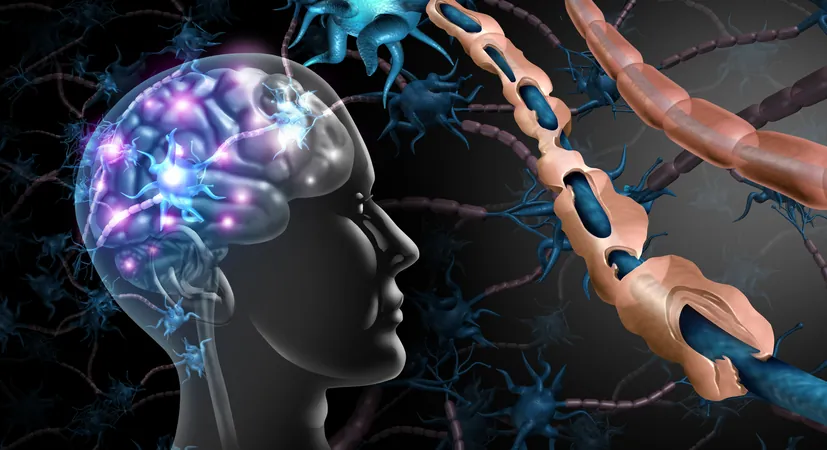
Groundbreaking Biomarkers Could Change the Game for Multiple Sclerosis Treatment
2024-09-20
Author: Yu
Groundbreaking Biomarkers Could Change the Game for Multiple Sclerosis Treatment
A pioneering study has unearthed two critical biomarkers that possess the potential to forecast whether disability will escalate in individuals who have recently received a diagnosis of multiple sclerosis (MS). These findings could pave the way for more targeted and effective therapeutic strategies tailored to the specific needs of MS patients.
The study highlights the crucial role of two proteins in the bloodstream that are indicative of neural damage: serum neurofilament light chain (sNfL) and serum glial fibrillary acidic protein (sGFAP). The former is linked to nerve injury, while the latter originates from astrocytes and is released during instances of inflammation or injury within the central nervous system (CNS).
Researchers found that varying levels of these proteins, along with their interrelationship, could serve as predictors for the future disability trajectories of MS patients and the most suitable drug interventions for their conditions.
“The identification of sNfL and sGFAP as predictive biomarkers allows us to tailor treatment strategies for MS patients more effectively,” stated Dr. Enric Monreal from Ramón y Cajal University Hospital, who presented the findings at a prominent European MS conference in Copenhagen this week. He stressed that these results highlight the urgent necessity for personalized treatment methodologies to adequately address the needs of the millions enduring MS worldwide, particularly those grappling with chronic disabilities that severely diminish their quality of life.
For patients exhibiting low levels of both biomarkers, the prognosis appears favorable, allowing treatment options to include either injectable or oral disease-modifying treatments (DMTs). Conversely, those with high levels of sNfL tend to have less favorable responses to standard treatments, showing considerable improvement when administered with high-efficacy DMTs such as natalizumab, alemtuzumab, ocrelizumab, rituximab, and ofatumumab.
The complexity of treating MS is further compounded for patients with elevated sGFAP but low sNfL levels, as this subgroup tends to demonstrate poor responses to existing DMTs, indicating an urgent need for novel therapeutic methods.
Dr. Monreal elaborated, "These distinct pathological pathways in MS carry profound therapeutic implications, as the traditional DMTs primarily focus on the peripheral adaptive immune system, often neglecting central nervous system immunity. Therefore, identifying patients exhibiting heightened levels of peripheral inflammation is vital in staving off disability and promoting better patient outcomes."
Disability levels in MS patients stem from two principal mechanisms: incomplete recovery post-relapse, termed relapse-associated worsening (RAW), or the steady progression of disability independent of any relapse activities, identified as progression independent of relapse activity (PIRA).
Analyzing blood samples from 725 patients across 13 hospitals in Spain and Italy revealed that increased levels of sNfL at MS onset corresponded to a 45% heightening of the risk of RAW and a 43% elevation in the likelihood of PIRA. Notably, those with high levels of sGFAP but low sNfL levels faced an astonishing 86% increase in PIRA risk and did not respond favorably to standard treatments. Importantly, sGFAP levels only accurately predicted PIRA among patients showing low sNfL levels.
“By measuring both sNfL and sGFAP at the onset of the disease, we can derive vital insights into the progressive pathways of MS. This enables clinicians to pinpoint the optimal patients for particular DMTs,” Monreal noted. “This strategy aims to prevent future disabilities while steering clear of unnecessary treatment-related risks for those deemed low-risk.”
As researchers continue to probe the intricacies of MS, this breakthrough study may revolutionize the treatment landscape, optimizing patient care and empowering those affected by this challenging condition. This critical advancement beckons further exploration into personalized approaches, ensuring the best possible outcomes for all patients battling multiple sclerosis.
Stay tuned as science inches closer to transforming the lives of millions worldwide!




 Brasil (PT)
Brasil (PT)
 Canada (EN)
Canada (EN)
 Chile (ES)
Chile (ES)
 Česko (CS)
Česko (CS)
 대한민국 (KO)
대한민국 (KO)
 España (ES)
España (ES)
 France (FR)
France (FR)
 Hong Kong (EN)
Hong Kong (EN)
 Italia (IT)
Italia (IT)
 日本 (JA)
日本 (JA)
 Magyarország (HU)
Magyarország (HU)
 Norge (NO)
Norge (NO)
 Polska (PL)
Polska (PL)
 Schweiz (DE)
Schweiz (DE)
 Singapore (EN)
Singapore (EN)
 Sverige (SV)
Sverige (SV)
 Suomi (FI)
Suomi (FI)
 Türkiye (TR)
Türkiye (TR)
 الإمارات العربية المتحدة (AR)
الإمارات العربية المتحدة (AR)